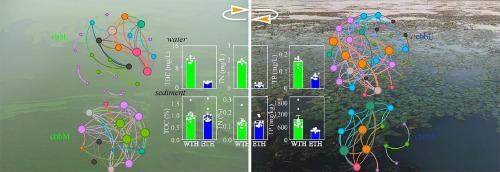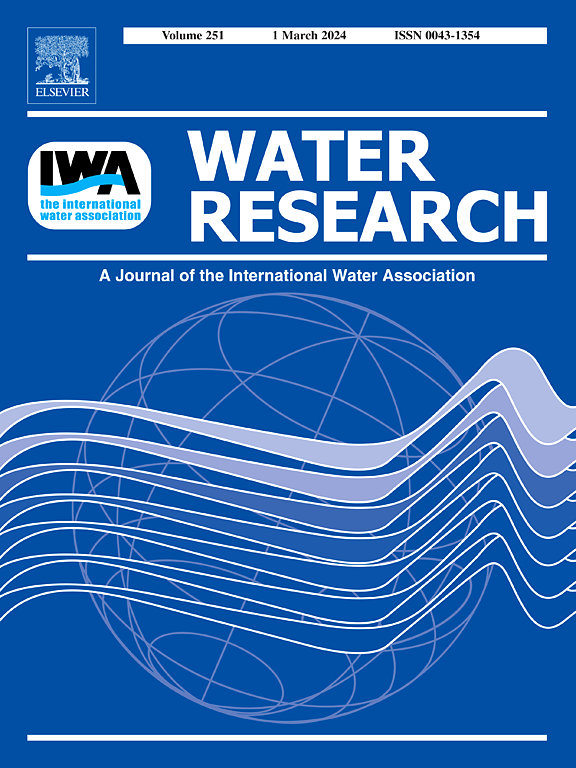Regime difference between macrophyte and Cyanophyta dominance regulate microbial carbon sequestration mode in lake sediments
IF 11.4
1区 环境科学与生态学
Q1 ENGINEERING, ENVIRONMENTAL
引用次数: 0
Abstract
Different nutrient load in the lake ecosystems trigger the regime difference and change of predominant biotype. The regulation of carbon (C) sequestration mode in the lacustrine sediments in response to this process need prudent clarification. Fluorescence measurements and high-throughput sequencing for functional genes cbbL and cbbM encoding C-fixing bacteria genus were executed for sediments from two representative regimes dominated by macrophyte and Cyanophyta, respectively. The results showed that humic-like and fulvic-acid like materials dominated the dissolved organic matter (DOM) from the algae and macrophyte-dominated lake regions, respectively. Microbial assimilation played critical influence on C fixation into the sediments in both of the two regimes. However, higher diversity was detected in macrophyte-dominated regime compared to that in Cyanophyta-dominated regime, suggesting that moderate nutrient levels facilitated the species richness of bacteria encoding functional genes concerning C fixation. Bacterial species and diversities varied between two regimes including predominant and rare taxa, suggesting that community structure alteration due to regime difference triggered the regulation the C sequestration mode and stability. Predominant genera manipulated the abundance of C-fixing bacteria genes in response to the regulation of nutrient levels. Noted that rare genera also responded to the regime difference and played key role in C sequestration into lacustrine sediments. Our results suggest that more abundant macrophyte-dominated regime facilitated the C sequestration in the lake ecosystems for atmospheric C reduction.

大型底栖生物和蓝藻占优势的制度差异调控湖泊沉积物中的微生物固碳模式
湖泊生态系统中不同的营养物质负荷会引发系统差异和主要生物类型的变化。在这一过程中,湖泊沉积物中碳(C)固存模式的调控需要审慎阐明。研究人员分别对以大型植物和蓝藻为主的两种代表性水系的沉积物进行了荧光测量和高通量测序,以检测编码固碳菌属的功能基因 cbbL 和 cbbM。结果表明,藻类和大型藻类主导湖区的溶解有机物(DOM)分别以腐植酸类和富里酸类物质为主。微生物的同化作用对两种水体中沉积物的碳固定起着至关重要的作用。然而,与藻类为主的湖区相比,在大型藻类为主的湖区发现了更高的多样性,这表明适度的营养水平促进了编码固碳功能基因的细菌物种的丰富性。两种生物群落中的细菌种类和多样性存在差异,包括优势类群和稀有类群,这表明生物群落结构的改变是由生物群落的差异引起的,从而调节了固碳模式和稳定性。优势菌属操纵固碳细菌基因的丰度,以应对营养水平的调节。我们注意到,稀有菌属也对水系差异做出了响应,并在固碳到湖底沉积物中发挥了关键作用。我们的研究结果表明,更丰富的大型藻类占主导地位的湖泊生态系统有利于固碳,从而减少大气中的碳含量。
本文章由计算机程序翻译,如有差异,请以英文原文为准。
求助全文
约1分钟内获得全文
求助全文
来源期刊

Water Research
环境科学-工程:环境
CiteScore
20.80
自引率
9.40%
发文量
1307
审稿时长
38 days
期刊介绍:
Water Research, along with its open access companion journal Water Research X, serves as a platform for publishing original research papers covering various aspects of the science and technology related to the anthropogenic water cycle, water quality, and its management worldwide. The audience targeted by the journal comprises biologists, chemical engineers, chemists, civil engineers, environmental engineers, limnologists, and microbiologists. The scope of the journal include:
•Treatment processes for water and wastewaters (municipal, agricultural, industrial, and on-site treatment), including resource recovery and residuals management;
•Urban hydrology including sewer systems, stormwater management, and green infrastructure;
•Drinking water treatment and distribution;
•Potable and non-potable water reuse;
•Sanitation, public health, and risk assessment;
•Anaerobic digestion, solid and hazardous waste management, including source characterization and the effects and control of leachates and gaseous emissions;
•Contaminants (chemical, microbial, anthropogenic particles such as nanoparticles or microplastics) and related water quality sensing, monitoring, fate, and assessment;
•Anthropogenic impacts on inland, tidal, coastal and urban waters, focusing on surface and ground waters, and point and non-point sources of pollution;
•Environmental restoration, linked to surface water, groundwater and groundwater remediation;
•Analysis of the interfaces between sediments and water, and between water and atmosphere, focusing specifically on anthropogenic impacts;
•Mathematical modelling, systems analysis, machine learning, and beneficial use of big data related to the anthropogenic water cycle;
•Socio-economic, policy, and regulations studies.
 求助内容:
求助内容: 应助结果提醒方式:
应助结果提醒方式:


